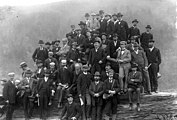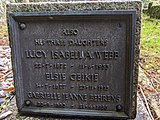Archibald Geikie
Archibald Geikie | |
|---|---|
 Sir Archibald Geikie, by Wener & Son. | |
| Born | 28 December 1835 Edinburgh,Scotland |
| Died | 10 November 1924(aged 88) Haslemere,England |
| Awards | Murchison Medal(1881) Wollaston Medal(1895) Royal Medal(1896) Hayden Memorial Geological Award(1902) |
| Scientific career | |
| Fields | Geology |
Sir Archibald GeikieOMKCBFRSFRSE(28 December 1835 – 10 November 1924) was a Scottish geologist and writer.[1][2]
Early life[edit]
Geikie was born in Edinburgh in 1835, the eldest son of Isabella Thom and her husbandJames Stuart Geikie,a musician and music critic. The elder brother ofJames Geikie,he was educated atEdinburgh High SchoolandUniversity of Edinburgh.[3]
Career[edit]
In 1855 was appointed an assistant on theBritish Geological Survey.He inaugurated his long list of works withThe Story of a Boulder; or, Gleanings from the Note-Book of a Geologist(1858). His ability at once attracted the notice of his chief,Sir Roderick Murchison,with whom he formed a lifelong friendship, and whose biographer he subsequently became.[2]
With Murchison some of his earliest work was done on the complicated regions of theschistsof theScottish Highlands;and the smallgeological mapofScotlandpublished in 1862 was their joint work: a larger map was issued by Geikie in 1892. In 1863 he published an important essay "On the Phenomena of the Glacial Drift of Scotland", inTransactions of theGeological Society of Glasgow,in which the effects of ice action in that country were for the first time clearly and connectedly delineated.[2]
In 1865 Geikie'sScenery of Scotland(3rd edition, 1901) was published, which was, he claimed, the first attempt to elucidate in some detail the history of thetopographyof a country. In the same year he was elected aFellowof theRoyal Society.[4]At this time the Edinburgh school of geologists, prominent among themSir Andrew Ramsay,with hisPhysical Geology and Geography of Great Britainwere maintaining the supreme importance ofdenudationin the configuration of land surfaces, and particularly theerosionofvalleysby the action of running water. Geikie's book, based on extensive personal knowledge of the country, was an able contribution to the doctrines of the Edinburgh school, of which he himself soon began to rank as one of the leaders.[2]In 1880, he was elected as a member to theAmerican Philosophical Society.[5]
Geological Survey[edit]

In 1867, when a separate branch of the Geological Survey was established for Scotland, he was appointed director. On the foundation of the Murchison professorship of geology andmineralogyat theUniversity of Edinburghin 1871, he became the first occupant of thechair.[2]He continued to hold these two appointments until 1881. In that year, he was awarded theMurchison Medalof theGeological Society of London[1]and he succeeded Sir Andrew Ramsay in the joint offices of Director-General of the Geological Survey of the United Kingdom and Director of theMuseum of Practical Geology,London, from which he retired in February 1901. A feature of his tenure of office was the impetus given to microscopicpetrography,a branch of geology to which he had devoted special study, by a splendid collection ofthin sectionsof Britishrocks.Later he wrote two Survey Memoirs,The Geology of Central and Western Fife and Kinross(1900), andThe Geology of Eastern Fife(1902).[2]
From the outset of his career, when he started to investigate the geology ofSkyeand other of theWestern Isles,he took a keen interest involcanicgeology, and in 1871 he brought before the Geological Society of London an outline of theTertiaryvolcanic history of Britain. Many difficult problems, however, remained to be solved. Here he was greatly aided by his extensive travels not only throughout Europe, but in western America. While thecanyonsof theColorado Riverconfirmed his long-standing views on erosion, the volcanic regions ofWyoming,MontanaandUtahsupplied him with valuable data in explanation of volcanic phenomena. The results of his further researches were given in an essay entitled "The History of Volcanic Action during the Tertiary Period in the British Isles," inTransactions of the Royal Society of Edinburgh(1888). His views on volcanic geology were delivered in his presidential addresses to the Geological Society of London in 1891 and 1892 and afterward embodied in his bookThe Ancient Volcanoes of Great Britain(1897). Other results of his travels are collected inGeological Sketches at Home and Abroad(1882).[2]
Writings[edit]
Geikie wrote a biography ofEdward Forbes(with G Wilson), and biographies of his predecessorsSir Roderick Impey Murchison(two volumes, 1875) and SirAndrew Crombie Ramsay(1895). His bookFounders of Geologyconsists of the inaugural course of lectures (founded by Mrs George Huntington Williams) atJohns Hopkins University,Baltimore, delivered in 1897.[2]
In 1897 he issued aGeological Map of England and Wales, with Descriptive Notes.In 1898 he delivered theRomanes Lectures,which was published under the title ofTypes of Scenery and their Influence on Literature.The study ofphysical geographyin Great Britain improved largely due to his efforts. Among his works on this subject isThe Teaching of Geography(1887). His other books includeScottish Reminiscences(1904) andLandscape in History and other Essays(1905).[2]HisBirds of Shakespearewas published in 1916.[6]
He was the editor ofThe Geological Structure of the North-West Highlands of Scotland(1907, His Majesty's Stationery Office), written byB. N. Peach,John Horne,William Gunn (1837–1902),C. T. Clough,L. W. Hinxman,andJ. H. H. Teall.[7]
Honours and awards[edit]
Geikie was electedFellow of the Royal Societyin 1865.[8]Geikie was Foreign Secretary of the Royal Society from 1890 to 1894, Joint Secretary from 1903 to 1908 and elected president in 1909 and awarded theirRoyal Medalin 1896. He was President of theGeological Society of Londonin 1891 and 1892, and again in 1906 and 1907. He was also President of theBritish Associationin 1892.[2]

He received the honoraryDoctor of Laws(LL.D) from theUniversity of Glasgowin June 1901.[9]
He received aknighthood[10]in 1891, theKnight Commander of the Most Honourable Order of the Bathin 1907[11]and theOrder of Meritin 1914.[12]In 1905 he received the RSGSLivingstone Medal.
Dorsa Geikie,awrinkle ridgesystem on theMoon,and the mineralgeikielite,a magnesium-titanium oxide, are both named after him, as isGeikie Gorgein theNapier Rangein theKimberleyregion of Western Australia,Mount Geikiein the Canadian Rockies,Mount Geikiein Wyoming,Geikie Peakin the Grand Canyon, and theGeikie Slidein theAtlantic Oceannorthwest ofScotland.[13]
Death[edit]
He died at his home, "Shepherd's Down" inHaslemere,Surrey and is buried there in the village churchyard.[14]
Family[edit]
He had married, in 1871, Alice Gabrielle Anne Marie Pignatel, daughter of Eugene Pignatel of Lyons; they had a son Roderick (killed in early life) and three daughters, Lucie, Elsie and Gabrielle (also commemorated on an attachment to Geikie's memorial.[citation needed]
Gallery[edit]
-
Charles Doolittle Walcott,John Wesley Powell,and Sir Archibald Geikie on a geological field excursion to Harpers Ferry, West Virginia, May 1897, following the George Huntington Williams Memorial Lectures delivered by Sir Archibald Geikie at Johns Hopkins University
-
Group photo taken during the aforementioned geological field excursion to Harpers Ferry, West Virginia, May 1897. Sir Archibald Geikie is in the top row, second from the left, wearing a light-colored jacket.
-
Geikie's gravestone in St Bartholomew's churchyard, Haslemere, Surrey U.K. The inscription reads: "To the dear memory of Archibald Geikie OM KCB Born in Edinburgh 28 Dec 1835 Died at Haslemere 10 Nov 1924. Wisdom is a treasure that never faileth, Which they that use become the friends of God"
-
Attachment to Geikie's gravestone in memory of his daughters
Selected bibliography[edit]
- The Story of a Boulder: Or Gleanings from a Note-book of a Field Geologist(1858)
- Physical Geography(1877)
- Textbook of Geology– First edition (1882) – Second edition (1885) –Third edition (1893)
- Geological Sketches at Home and Abroad(1882)
- An Elementary Geography of the British Isles(1888)
- Memoir of Sir Andrew Crombie Ramsay(1895)
- The Ancient Volcanoes of Britain,2 volumes (1897)vol. 1vol. 2
- Types of Scenery and Their Influence on Literature(1898)
- The Founders of Geology–First edition (1897)–Second edition (1905)
- Elementary Lessons in Physical Geography(1903)
- Scottish Reminiscences(1904)
- Landscape in History and Other Essays(1905)[15]
- Annals of the Royal Society Club(1917)
See also[edit]
References[edit]
- ^ab"Geikie, Sir Archibald".Who's Who.A & C Black.(Subscription orUK public library membershiprequired.)
- ^abcdefghijChisholm, Hugh,ed. (1911)..Encyclopædia Britannica.Vol. 11 (11th ed.). Cambridge University Press. pp. 552–553.
- ^Oldroyd, David. "Geikie, Sir Archibald (1835-1924), geologist and historian".Oxford Dictionary of National Biography(online ed.). Oxford University Press.doi:10.1093/ref:odnb/33364.(Subscription orUK public library membershiprequired.)
- ^"Library and Archive Catalogue".Royal Society.Retrieved31 January2011.
- ^"APS Member History".Archivedfrom the original on 14 May 2021.
- ^Geikie, Archibald (1916).The birds of Shakespeare.Glasgow: J. Maclehose and Sons.OCLC3524020.
- ^"Review ofThe Geological Structure of the North-West Highlands of Scotlandedited by Archibald Geikie ".The Athenaeum(4175): 554–555. 2 November 1907.
- ^"Archibald Geikie"– via Royal Society.
- ^"Glasgow University Jubilee".The Times.No. 36481. London. 14 June 1901. p. 10.Retrieved5 January2024– via Newspapers.com.
- ^"No. 26190".The London Gazette.7 August 1891. p. 4244.
- ^"No. 28050".The London Gazette.13 August 1907. p. 5527.
- ^"The New Year's Honours. Five New Peers., Six Baronets: Forty Knights., Appointment To Order Of Merit".The Times.No. 40409. London. 1 January 1914. col G, p. 9.
- ^"Geikie Slide and Hebridean Slope Marine Protected Area (MPA)"(PDF).Joint Nature Conservation Committee.Retrieved23 October2019.
- ^Biographical Index of Former Fellows of the Royal Society of Edinburgh 1783–2002(PDF).The Royal Society of Edinburgh. July 2006.ISBN0-902-198-84-X.Archived fromthe original(PDF)on 24 January 2013.Retrieved26 June2016.
- ^"Review ofLandscape in History, and other Essaysby Sir Archibald Geikie ".The Athenaeum(4043): 504–505. 22 April 1905.
External links[edit]
- Sir Archibald Geikie O.M. K.C.B.– Museum site with extensive biographical material, including pictures
- "The Birds of Shakespeare".Archived from the original on 8 July 2007.Retrieved2006-11-18.
{{cite web}}:CS1 maint: bot: original URL status unknown (link)by Sir Archibald Geikie - The Story of a Boulder; or, Gleanings from the notebook of a field geologistby Sir Archibald Geikie, 1858
- Biographical detailsArchived19 June 2023 at theWayback Machineon the site ofHaslemere Educational Museum
- Portraits of Archibald Geikieat theNational Portrait Gallery, London
- Works by or about Archibald GeikieatInternet Archive
- Works by Archibald GeikieatLibriVox(public domain audiobooks)

- 1835 births
- 1924 deaths
- Alumni of the University of Edinburgh
- British Geological Survey
- British volcanologists
- Fellows of the Royal Society
- Fellows of the Royal Society of Edinburgh
- Foreign associates of the National Academy of Sciences
- Honorary members of the Saint Petersburg Academy of Sciences
- Knights Bachelor
- Knights Commander of the Order of the Bath
- Members of the Order of Merit
- People educated at the Royal High School, Edinburgh
- Scientists from Edinburgh
- Presidents of the British Science Association
- Presidents of the Royal Society
- Royal Medal winners
- Scottish biographers
- Scottish cartographers
- Scottish geologists
- Murchison Medal winners
- Wollaston Medal winners
- Presidents of the Classical Association
- Directors of the British Geological Survey
- Presidents of the Geological Society of London




